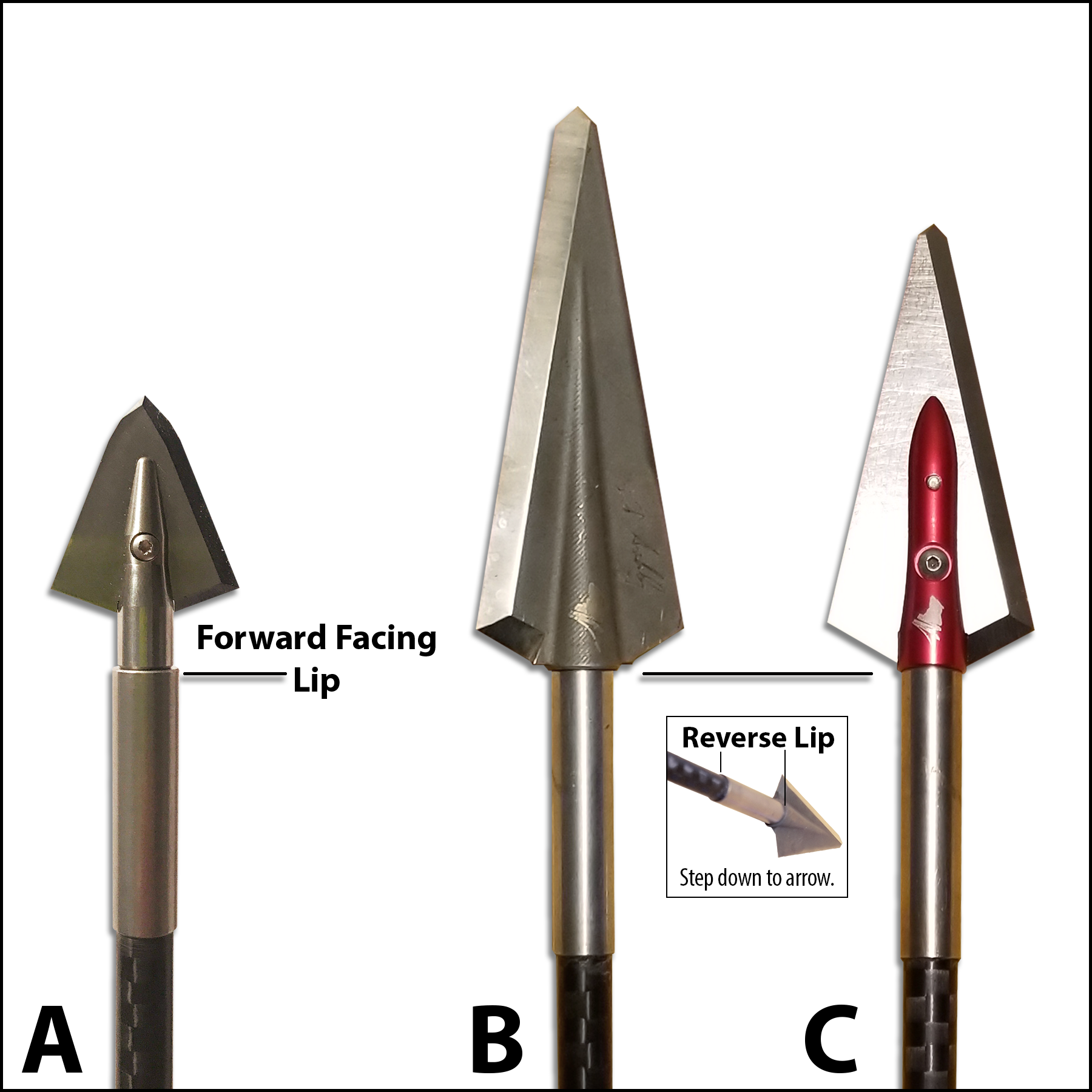Rethinking Arrow and Broadhead Performance
A NEW Series of Bowhunting Articles by the Ashby Bowhunting Foundation
Article 6: Factor 5 – Shaft Diameter to Ferrule Ratio
Would you like to hunt with arrows and broadheads that give you pass-throughs on big game shot after shot? Would you like to have complete confidence in your arrows and broadheads to give you lethal penetration and reliable kills even if you hit bone? Of course, you would! Every serious bowhunter wants that kind of performance from their setup. Join us for Dr. Ed Ashby’s Top 12 Penetration Enhancement Factors.
After extensive testing, Dr. Ed Ashby identified twelve specific arrow penetration enhancement factors. He then ranked them in order of importance so that bowhunters would have a straightforward guide as to what they should build into their arrow and broadhead setups—and in what order—so they could create the most reliable and lethal setups possible.
To optimize your arrow and broadhead builds, it is recommended that you incorporate as many of the 12 Penetration Enhancement Factors as possible. The fifth factor, Shaft Diameter to Ferrule Diameter Ratio, will be discussed today.
“Shaft-diameter to ferrule-diameter ratio is factor number five. It shows an average 10 percent penetration-gain when the shaft is at least 5 percent smaller than the broadhead’s ferrule diameter; compared to a case where shaft and broadhead ferrule have equal diameter. When shaft diameter exceeds that of the broadhead’s ferrule penetration is decreased by an average of 30 percent; compared to a case where shaft and broadhead ferrule have equal diameter. That’s a 40 percent difference in tissue penetration when a shaft having a favorable ratio is compared to one with an unfavorable ratio. (See 2004 Update, Part 2.) Regardless of other design factors present or absent, you should avoid use of arrows having a shaft diameter greater than that of your broadhead’s ferrule. Ideally, your arrow’s shaft should be at least 5 percent smaller in diameter than your broadhead’s ferrule.” quoted from Dr. Ed Ashby (2019 Terminal Arrow Performance Update)
Shaft Diameter to Ferrule Diameter ratio is one of the simpler factors to evaluate. Essentially, it boils down to whether or not the ferrule of your broadhead is LARGER, EQUAL, or SMALLER than where it meets the shaft. Pretty simple, right? Unfortunately, its simplicity is also a big reason why it often gets overlooked.
First, let’s look at some quick history.
While this isn’t as big of an issue anymore, there used to be much more variability in the size of broadhead ferrules. Some ferrules were larger and intended to match the older, larger aluminum shafts. Others were smaller to match specific carbon shaft sizes. You really needed to pay attention to exactly what you were using in order to prevent yourself from unintentionally creating an issue. In today’s market, there is much more consistency in ferrule size with the vast majority being 5/16-inch or slightly larger, but there are still some oddballs on the market that are slightly smaller.
The bigger issue that has arisen in the last few years is on the shaft side. As more and more people have started focusing on durability, the prevalence of outserts has increased, which is great, but it means you need to pay a bit more attention to how things line up. Adding an outsert will inherently increase the diameter of the shaft so, depending on the starting size of the carbon, you can easily end up beyond the typical ferrule diameter. As we have discussed previously, there needs to be some balance and we do not want to improve one factor at the expense of another.
So how much of an impact can this have on overall performance? Why does something as minor as a tiny lip need to be part of our evaluation of an arrow system?
As we have seen in previous articles, it all boils down to drag and overall resistance, and a blunt lip can create a significant amount of resistance.
- When shaft diameter (or outsert diameter) is larger than the ferrule of your broadhead penetration is decreased by an average of 30 percent when compared to a shaft and ferrule that are equal or matching diameters.
- When the shaft diameter (or outsert diameter) is at least 5 percent smaller than the ferrule of your broadhead penetration is increased by an average of 10 percent. (See 2004 Update Part 2).
[box] That’s a 40 percent swing! It’s incredible how something as seemingly “minor” as a small lip at the transition from your broadhead ferrule to the shaft can create enough resistance to reduce penetration by 40 percent, but that’s the reality—and why it’s important to focus on the details.[/box]
Knowing this, it’s important to consider this factor when evaluating a potential new build. Consider the following.
- What is the ferrule diameter of the desired broadhead?
- What is the diameter of the desired shaft?
- What is the diameter of the desired component?
When doing this evaluation there are a few things to keep in mind.
- If the desired shaft is “standard” diameter (0.244/0.245/0.246 ID), then the vast majority of broadhead ferrules will be EQUAL to the shaft.
- EQUAL diameters, while not ideal, are still acceptable.
- If an outsert is added, the ferrule will now be SMALLER, drastically reducing overall penetration potential
- One option is to look for a component that is longer (internally), providing more shaft support and improved durability without the addition of a sleeve.
- A second option would be to narrow your broadhead search to those with larger ferrules. These will primarily be intended for larger game and/or crossbow bolts.
- If the desired shaft is a “small” diameter (0.203/0.204/0.205 ID) or a “micro” diameter (0.165/0.166/0.167 ID), then the shaft size will be of minimal concern (unless using an extremely stiff spine) and the main focus should be on the max diameter of the component. The vast majority of these type of shafts utilize some form of a half-out or outsert, which will be larger than the shaft itself. Typically, these “out” portions of the component are intentionally designed to match or be slightly undersized with a typical 5/16-inch ferrule. Matching the ferrule and component diameter in these situations is acceptable as you will see a similar reduction in drag when the component necks down to the carbon shaft.

Note: Some insert/outsert setups on tapered arrows are the same diameter as the ferrule or slightly less where they meet, and once you get past that insert/outsert, the arrow itself is smaller in diameter than the back of the broadhead ferrule—and continues to get smaller the further the arrow penetrates.
The bottom line when it comes to the shaft diameter to ferrule diameter ratio is that you want to avoid any forward-facing lip caused by the insert/outsert being larger in diameter than the ferrule of your broadhead. At a minimum, you want to ensure that the broadhead and insert/outsert are equal in diameter, but—if at all possible—the shaft should be at least 5 percent smaller in diameter than the broadhead ferrule in order to maximize your overall potential.
Get to know the authors!
[author] [author_image timthumb=’on’]https://www.biggame.org/wp-content/uploads/2021/06/dr-ed-ashby-bio-pic-002.jpg[/author_image] [author_info]Dr. Ed Ashby
Dr. Ed Ashby, a legend in the archery hunting community, dedicated more than 27 years to the study of arrow performance and broadhead lethality. His involvement in the historic Natal Study helped validate just how lethal archery equipment could be on all sized big game animals and was the main reason that bowhunting was ever legalized in South Africa. [/author_info] [/author]
[author] [author_image timthumb=’on’]https://www.biggame.org/wp-content/uploads/2021/06/rob-hummel-bio-pic-002.jpg[/author_image] [author_info] Rob Hummel
With a background in fabrication and engineering, the current standard being pushed by the industry didn’t feel right when Rob first entered the world of archery. Fortunately, after being directed to some of the reports from Dr. Ed Ashby’s field research it all began to align with the mechanics he already understood. Over the last decade, Rob has continued pushing to bring consistent lethality to the forefront of the archery industry. [/author_info] [/author]
[author] [author_image timthumb=’on’]https://www.biggame.org/wp-content/uploads/2021/06/todd-michael-smith-bio-pic-002.jpg[/author_image] [author_info] Todd Smith
For over 40-years, his passion for bowhunting and thirst for knowledge and understanding have driven Todd to learn everything he could about arrows, broadheads, and arrow lethality. Todd is an author, public speaker, and has helped to educate tens of thousands of bowhunters on how to set themselves up for bowhunting successes by using proven – lethal – arrow and broadhead set-ups.[/author_info] [/author]

[box] What’s the Ashby Bowhunting Foundation all about?
The Ashby Bowhunting Foundation is dedicated to continuing Dr. Ed Ashby’s research and to ensuring that bowhunters everywhere will have free access to information that will help them build extremely lethal and reliable arrow and broadhead setups for all species of big game. The foundation was started in 2017 to continue the work of Dr. Ed Ashby that has benefited bowhunters worldwide for decades. The Foundation’s goal is to provide information to achieve the highest possible success rate and reduce the wound/non-recovery rate of big game to the lowest level possible. Through a program of continuing research, the Foundation seeks to find the most lethal arrow setups, taking into account all possible hits under real hunting conditions, controlled testing and using freshly culled animals. The results of this testing is always made available to the global bowhunting community free of cost, utilizing multi-media outlets for information and test results. The Ashby Bowhunting Foundation is excited for this opportunity to partner with DSC and to share these articles with all DSC members so they can make informed decisions of whether to change to arrow and broadhead combinations that will increase their odds of bowhunting success under all situations and conditions. For more information please visit: https://www.biggame.org/ashby-bowhunting-foundation [/box]




